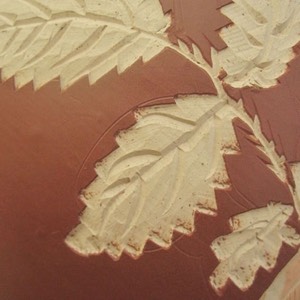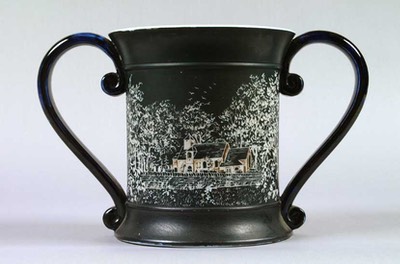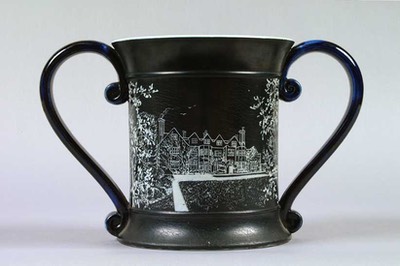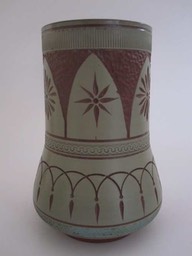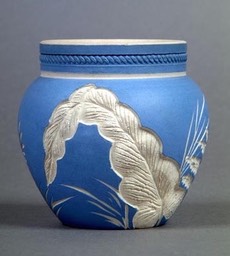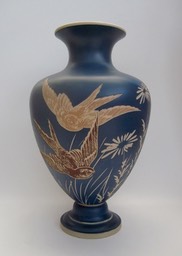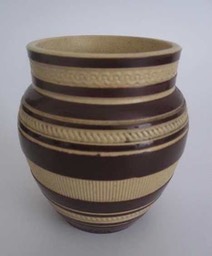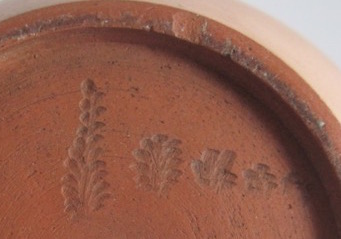
Base of an incised vase with five small incised “doodles” which appear to show the growth of a fern frond.
- Incised or sgraffito ware is the most recognisable and characteristic art pottery produced by the Benthall Pottery Company.
- This range of ware appears to have been in production as early as 1884, if this is how a reference to “Salopian cut pottery from Benthall” is to be interpreted (Wellington Journal & Shrewsbury News, 29 November 1884).
- It was certainly in production by 1887, as evidenced by an advertisement from J. & B. Blower, Pride Hill, Shrewsbury, for “Sgraffiato, The New Salopian Art Pottery … at prices ranging from 6d to 5s 6d. Each article stamped ‘Salopian’ “ (Wellington Journal & Shrewsbury News, 24 December 1887). An editorial comment in the same edition, referring to the display of sgraffito ware at Messrs Blower’s, describes it as “… a most artistic novelty, and fit to adorn any abode, while its cheapness brings it within the reach of the majority."
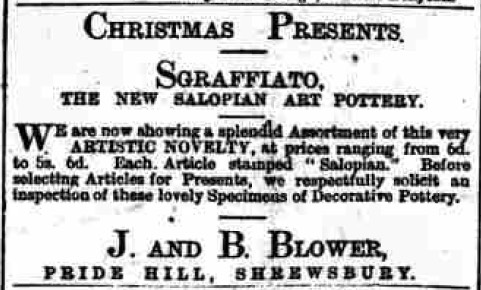
- Maud Whitmore (née Hall), a worker employed at Benthall Pottery c.1918–1924, interviewed in 1987, recalled that much of the incised decoration was the work of James Arthur “Arty” Hartshorne
(Edmundson 2002). - Decoration was applied by:
1. Freehand drawing – cutting by hand through the coloured surface slip into the body of the vessel. A skilled job for an accomplished decorator as every cut had to be made in the right place with no room for error.
2. A few very uncommon pieces appear to have incised decoration applied by moulding, not hand-incising.
3. Using a small stamp-wheel to apply a band of rouletting around the neck of the piece. - Pieces usually have a matt eggshell finish; a few have a clear high-gloss glaze; leaves, ferns and flowers are sometimes highlighted with coloured slips.
- There are four distinct styles of incised ware:
1. Geometric
The decoration features compass-drawn patterns of interlocking arcs and circles.
2. Fern and flower
Freehand decoration featuring ferns, grasses, bracken, spiky leaves, bramble, daisies, buttercups, passion flowers, roses, and many others.
These pieces are the most frequently encountered examples of Salopian Art Pottery.
Pieces incised with varieties of ferns are recognised as part of the Victorian fashion for ferns, termed “pteridomania” ("fern madness” or “fern craze") by the writer Charles Kingsley in 1855.
Many leading British potteries produced wares with fern decoration, including Dudson, Wedgwood, Minton, Worcester and George Jones. The fashion for fern-decorated wares as at its height in the 1860–1880 period, and by the time the Benthall Pottery Company entered the craze the popularity was in decline.
Pieces of fern-decorated Salopian Art Pottery probably date to the period c.1890–1910, and possibly some time after. It’s possible to identify some varieties of fern seen on Salopian Art Pottery, though most are generic with their depiction determined by the incising technique. The base of one piece of incised ware has five small “doodles” of ferns (see image, right).
3. Animal
Freehand decoration featuring animal subjects, typically insects (butterflies and moths), birds (sparrows, swallows, plovers/peewits, hawks, owls, pheasants, ducks), dogs, and even a solitary spider.
4. Banded and rouletted
Included in the incised ware category are pieces with banded and rouletted decoration.
Note: this is a broad classification of styles – pieces are found with characteristics that mix two styles (i.e. animal subjects occur on pieces with both geometric and floral decoration). - A unique piece with landscape decoration also exists, featuring a view of Benthall Hall and Benthall Church; this is presumed to have been a commissioned piece (see images, right).
- Two pieces with unusual incised designs featuring ferns, inscriptions and Christian symbols are known (see Mystery pieces).
- Incised ware is usually marked with a simple impressed SALOPIAN mark. The mark occurs on bases and also on the body, low down near the base where it’s often seen as a partial mark, having been cut away by the incised decoration. Unmarked pieces also exist, but attributions can be safely made by comparison with marked pieces.
- Click on an image below to view the relevant page.
